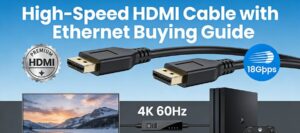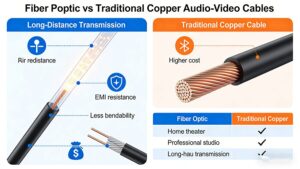Im September 2023 kündigte Intel Thunderbolt 5 an, einen neuen Standard für Hochgeschwindigkeitsschnittstellen, der Technikbegeisterte in helle Aufregung versetzt. Eine der drängendsten Fragen, die sich jeder stellt, ist: Ist Thunderbolt 5 abwärtskompatibel? Die kurze Antwort ist ein klares Ja, und hier ist, was Sie wissen müssen.
Kompatibilität mit früheren Thunderbolt-Versionen
Thunderbolt 5 ist mit dem USB4 V2-Standard konform, was für bestehende Thunderbolt-Nutzer eine gute Nachricht ist. Diese Konformität ermöglicht die Abwärtskompatibilität mit früheren Versionen von Thunderbolt, nämlich Thunderbolt 3 und Thunderbolt 4.
Wenn Sie zum Beispiel eine externe Festplatte mit einem Thunderbolt 3-Anschluss haben, können Sie diese einfach an einen Thunderbolt 5-Anschluss Ihres neuen Computers anschließen. Es ist jedoch wichtig zu beachten, dass die Datenübertragungsrate auf die Fähigkeiten des Thunderbolt 3-Geräts beschränkt ist. Thunderbolt 3 hat in der Regel eine maximale Datenübertragungsrate von 40 Gbit/s. Wenn Sie es also an einen Thunderbolt 5-Anschluss anschließen, wird die Übertragungsgeschwindigkeit diese Grenze nicht überschreiten.
|
Thunderbolt Version
|
Maximale Datenübertragungsrate
|
|
Thunderbolt 3
|
40 Gbit/s
|
|
Thunderbolt 4
|
40 Gbit/s
|
|
Thunderbolt 5
|
80 Gbit/s (bis zu 120 Gbit/s mit Boost)
|

Unterstützung für USB 3-Geräte
Thunderbolt 5 kann auch mit USB 3-Geräten verwendet werden. Egal, ob Sie eine externe USB 3.0- oder USB 3.1-Festplatte, eine Webcam oder andere Peripheriegeräte besitzen, Sie können sie problemlos an einen Thunderbolt 5-Anschluss anschließen. Wie bei Thunderbolt 3 und 4-Geräten ist die Datenübertragungsgeschwindigkeit jedoch auf den USB 3-Standard begrenzt. USB 3.0 hat eine maximale Übertragungsrate von 5 Gbit/s, während USB 3.1 bis zu 10 Gbit/s erreichen kann.
DisplayPort 2.1-Kompatibilität
Ein weiterer Bereich, in dem Thunderbolt 5 seine Vielseitigkeit unter Beweis stellt, ist die Unterstützung von DisplayPort 2.1. Wenn Sie einen externen Monitor besitzen, der DisplayPort verwendet und mit DisplayPort 2.1 kompatibel ist, können Sie ihn direkt an einen Thunderbolt 5-Anschluss an Ihrem Computer anschließen. So können Sie hochauflösende Bilder genießen, mit Unterstützung für mehrere 8K-HDR-Monitore oder einzelne Displays mit Bildwiederholraten von bis zu 540 Hz.
Kompatibilität mit der Stromversorgung
Die Stromzufuhr ist ein weiterer Aspekt, bei dem Thunderbolt 5 Abwärtskompatibilität bietet. Er unterstützt bis zu 240 W Leistungsabgabe. Wenn Sie ein älteres Gerät anschließen, z. B. ein Thunderbolt 4-Gerät, das in der Regel eine Leistungsabgabe von bis zu 100 W unterstützt, passt der Thunderbolt 5-Anschluss die Leistungsabgabe automatisch an die Anforderungen des Geräts an.
Zusammenfassend lässt sich sagen, dass Thunderbolt 5 eine breite Abwärtskompatibilität bietet, was es zu einer attraktiven Option für Benutzer macht, die auf die neueste Technologie aufrüsten möchten, ohne alle ihre vorhandenen Peripheriegeräte ersetzen zu müssen. Egal, ob es sich um ein altes Thunderbolt-fähiges Gerät oder ein einfaches USB-3-Gerät handelt, die Wahrscheinlichkeit ist groß, dass es mit einem Thunderbolt-5-Anschluss funktioniert, wenn auch mit der Geschwindigkeit und Funktionalität des älteren Gerätestandards.








